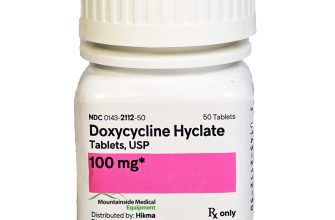Need to understand the differences between promethazine and prochlorperazine? Promethazine primarily combats nausea and allergic reactions, while prochlorperazine focuses on controlling severe nausea and vomiting, particularly those related to chemotherapy or other intense illnesses. This distinction is key for selecting the right medication.
Promethazine’s sedative effects are considerably stronger than prochlorperazine’s. Consider this crucial factor if you’re concerned about drowsiness or impaired alertness. Prochlorperazine carries a higher risk of extrapyramidal side effects, including muscle stiffness and tremors. Always discuss potential side effects with your doctor.
Both medications are prescription-only. Don’t attempt self-medication. A healthcare professional can assess your specific needs and determine the most appropriate treatment, considering your medical history and other medications you might be taking. Dosage will vary depending on the individual patient’s condition.
Remember: This information is for educational purposes only and does not constitute medical advice. Always consult a doctor or pharmacist before starting or changing any medication. They can provide personalized guidance and address any concerns you may have.
- Promethazine and Prochlorperazine: A Detailed Overview
- Promethazine
- Prochlorperazine
- Key Differences and Considerations
- Understanding the Individual Medications: Promethazine and Prochlorperazine
- Promethazine
- Prochlorperazine
- Combined Use: Synergistic Effects and Indications
- Potential Risks and Side Effects of Combined Use
- Respiratory Depression
- Cardiovascular Effects
- Neurological Effects
- Other Considerations
- Precautions and Patient Information: Safe and Effective Use
- Alcohol and Other Depressants
- Pregnancy and Breastfeeding
- Elderly Patients
- Potential Side Effects
- Storage and Disposal
- Missed Dose
- Allergic Reactions
- Regular Monitoring
Promethazine and Prochlorperazine: A Detailed Overview
Promethazine and prochlorperazine are both antiemetics, meaning they help prevent or relieve nausea and vomiting. However, they work through different mechanisms and have distinct uses.
Promethazine
Promethazine is a phenothiazine derivative primarily used as an antihistamine and antiemetic. Its antiemetic effects stem from its ability to block dopamine receptors in the brain’s chemoreceptor trigger zone. It’s also a sedative and possesses mild analgesic properties. Common uses include:
- Preoperative and postoperative nausea and vomiting
- Relief of nausea and vomiting associated with various causes
- Treatment of allergic reactions, particularly urticaria and angioedema
- Insomnia, as a sedative (use cautiously due to potential side effects)
Significant side effects include drowsiness, dizziness, dry mouth, and blurred vision. It can cause orthostatic hypotension, meaning a sudden drop in blood pressure upon standing. Patients should be aware of this potential risk.
Prochlorperazine
Prochlorperazine, another phenothiazine, is a potent antiemetic, primarily used for severe nausea and vomiting. Its mechanism is similar to promethazine, involving dopamine receptor blockade. However, it has a stronger antiemetic effect and is often reserved for more severe cases.
- Treatment of severe nausea and vomiting, including that induced by chemotherapy
- Management of severe vomiting in postoperative patients
- Control of nausea and vomiting associated with certain neurological conditions
Side effects are similar to promethazine but may be more pronounced, including extrapyramidal symptoms (EPS) such as muscle rigidity, tremors, and restlessness. These are more common with higher doses. Careful monitoring is crucial, especially in vulnerable patients.
Key Differences and Considerations
While both drugs share similarities, their potencies and side effect profiles differ. Prochlorperazine generally provides stronger antiemetic effects but carries a higher risk of EPS. Promethazine offers broader applications, including allergy management, but has less potent antiemetic activity. Dosage and choice should be guided by a healthcare professional based on the patient’s specific needs and medical history. Always adhere to prescribed dosages and inform your doctor of any side effects experienced.
Understanding the Individual Medications: Promethazine and Prochlorperazine
Promethazine and prochlorperazine are both antiemetics, meaning they help control nausea and vomiting. However, they work through different mechanisms and have distinct applications.
Promethazine
Promethazine is a phenothiazine derivative primarily acting as an antihistamine with additional anticholinergic and sedative effects. This makes it particularly useful for treating allergic reactions alongside nausea and vomiting. Expect drowsiness as a common side effect. Dosage varies depending on the condition, always follow your doctor’s prescription. It’s crucial to be aware of potential interactions with other medications, especially those affecting the central nervous system. Consult your doctor or pharmacist regarding potential drug interactions.
Prochlorperazine
Prochlorperazine, also a phenothiazine, works primarily by blocking dopamine receptors in the brain, reducing the signals that trigger vomiting. It’s often prescribed for more severe nausea and vomiting, especially those associated with chemotherapy or other medical conditions. While effective, it can cause extrapyramidal side effects (EPS), such as muscle stiffness and tremors, in some individuals. Doctors often monitor patients closely for these side effects. Remember, always take prochlorperazine as directed.
Key Differences: Promethazine’s sedative effects are stronger, while prochlorperazine is more potent in suppressing vomiting. The choice between them depends on the specific condition and individual patient response.
Disclaimer: This information is for educational purposes only and does not constitute medical advice. Always consult a healthcare professional before starting or changing any medication.
Combined Use: Synergistic Effects and Indications
Promethazine and prochlorperazine are often used together to leverage their complementary effects. Promethazine’s antihistaminic and sedative properties synergistically enhance prochlorperazine’s antiemetic action. This combination is particularly effective in managing severe nausea and vomiting, especially post-operatively or due to severe migraine.
The synergistic effect reduces the required dosage of each individual drug, minimizing potential side effects. This combination is frequently prescribed for patients undergoing chemotherapy or experiencing severe motion sickness, where potent antiemetic effects are necessary.
Clinicians should carefully monitor patients for excessive sedation, particularly in elderly individuals or those with pre-existing respiratory conditions. Dosage adjustments are crucial based on individual patient response and tolerance. Always refer to official prescribing information for detailed guidelines on dosage and administration. Regular monitoring of vital signs, especially blood pressure and heart rate, is recommended during combined use.
While this combination provides powerful relief from nausea and vomiting, it’s not suitable for all patients. Contraindications include known allergies to either medication, severe respiratory conditions, and certain neurological disorders. A thorough patient history is paramount before prescribing this combination.
Remember, this information is for educational purposes only and should not substitute advice from a healthcare professional. Always consult with a physician or pharmacist before starting any new medication, including this combination.
Potential Risks and Side Effects of Combined Use
Combining promethazine and prochlorperazine increases the risk of significant side effects, primarily due to their similar mechanisms of action and sedative properties. Expect heightened drowsiness, dizziness, and potentially impaired coordination. This combination significantly increases the risk of falls, especially in the elderly or those with pre-existing balance problems. Always discuss this combination with your doctor before use.
Respiratory Depression
A serious concern is the potential for respiratory depression, particularly in high doses or with underlying respiratory conditions. This risk necessitates careful monitoring, especially in patients with asthma or chronic obstructive pulmonary disease (COPD). Reduced breathing rate and shallow breaths should prompt immediate medical attention.
Cardiovascular Effects
Both drugs can lower blood pressure. Combining them may cause an excessive drop, leading to lightheadedness or fainting, particularly in individuals already prone to hypotension. Regular blood pressure monitoring may be necessary, especially during initial treatment.
Neurological Effects
Extrapyramidal symptoms, such as muscle stiffness, tremors, and involuntary movements, are more likely with concurrent use. These symptoms are typically managed by reducing dosage or switching medications. Severe cases require immediate medical intervention. Additionally, anticholinergic effects, including blurred vision and dry mouth, are amplified when both drugs are taken together.
Other Considerations
This combination can worsen existing constipation. Patients should increase fluid and fiber intake. Furthermore, the additive sedative effect can impair judgment and reaction time, making driving or operating machinery unsafe. Always prioritize safety and avoid these activities while taking this medication combination.
Precautions and Patient Information: Safe and Effective Use
Always inform your doctor about all medications you’re taking, including over-the-counter drugs and herbal supplements. This helps prevent dangerous drug interactions. Promethazine and prochlorperazine can cause drowsiness; avoid driving or operating machinery until you know how these medications affect you.
Alcohol and Other Depressants
Combining these medications with alcohol or other central nervous system depressants, such as opioids or benzodiazepines, significantly increases the risk of severe drowsiness, respiratory depression, and even death. Avoid alcohol and other depressants entirely while using promethazine and prochlorperazine.
Pregnancy and Breastfeeding
Discuss the use of these medications with your doctor if you are pregnant, breastfeeding, or planning to become pregnant. These drugs can pass into breast milk and may affect the baby. Your doctor can help determine the safest course of action.
Elderly Patients
Older adults are more susceptible to the side effects of promethazine and prochlorperazine, especially drowsiness and falls. Start with lower doses and carefully monitor for adverse reactions. Your doctor can adjust your dosage accordingly.
Potential Side Effects
Common side effects include drowsiness, dizziness, dry mouth, and constipation. Less common but serious side effects include low blood pressure, irregular heartbeat, and allergic reactions. Seek immediate medical attention if you experience any severe or unusual symptoms.
Storage and Disposal
Store medications in a cool, dry place, away from children and pets. Follow your pharmacist’s instructions on proper disposal of unused medication.
Missed Dose
If you miss a dose, take it as soon as you remember, unless it’s almost time for your next dose. Do not double the dose to catch up.
Allergic Reactions
Stop taking the medication and seek immediate medical help if you experience signs of an allergic reaction such as hives, swelling, difficulty breathing, or severe skin rash.
Regular Monitoring
Regular check-ups with your doctor are crucial to monitor your response to the medication and adjust the dosage as needed. Don’t hesitate to contact your doctor if you have any questions or concerns.








